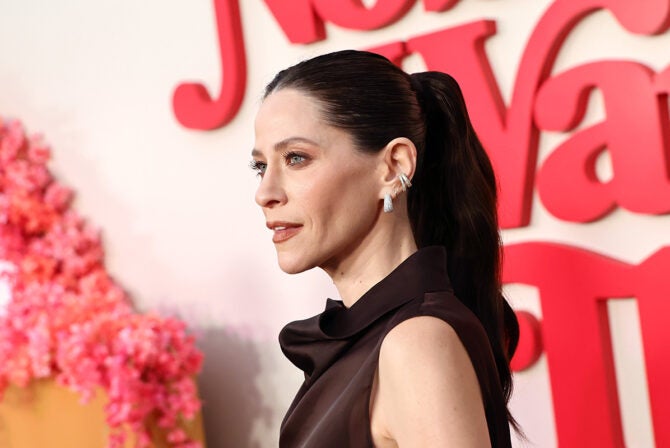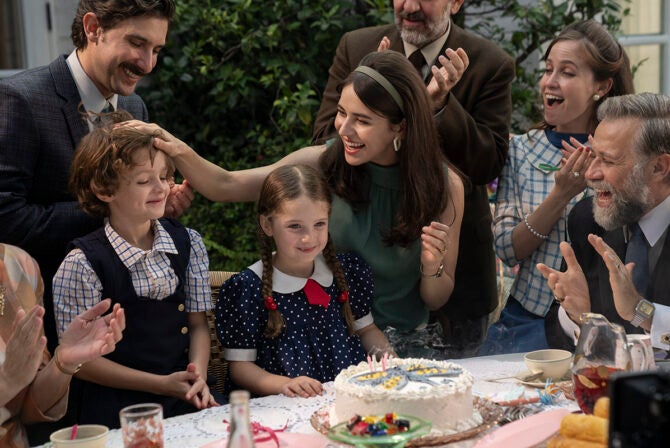The first trailer for “Lee,” the biopic about American photographer Lee Miller — the New York-born model-turned-fashion photographer-turned-photojournalist, who took incredibly harrowing and iconic pictures of WWII and in post-WWII Europe, including the first pictures of the Dachau concentration camp — is here. My main criticism about it is that it doesn’t have nearly enough Andy Samberg in it — though that’s really my criticism about most things in general.
In the movie, the former SNL and “Brooklyn Nine-Nine” star plays Life photographer David E. Scherman. Scherman was a New York native like Lee, though unlike her, he was Jewish. He traveled and worked with Miller when she was shooting pictures as Vogue’s war correspondent; with Miller, he was the first journalist to enter Hitler’s Munich’s apartment after the Nazi’s defeat and the end of the war.
While the movie , directed by Ellen Kuras, shows Miller’s life before and after the war, it mostly focuses on her work during it, a period in which she and Scherman were perhaps the most renowned and iconic photojournalists to take pictures from the frontlines.
“It happened so slowly, yet kind of overnight,” the trailer recounts of the rise of Nazism and the Second World War. “We woke up one morning and Europe was at war.”
The trailer focuses mostly on Miller, and in the glimpses it offers from the film, Winslet gives a truly powerful performance of the pioneering artist. Her Miller is full of chutzpah and confidence, and over and over she does not allow people in power to tell her what to do.
She tells Roland Penrose, played by Alexander Skarsgård, that she is never wrong. “I just want to do my part — why should men decide what that is,” Miller argues with her Vogue editor. A colonel that tells her that they don’t let women into the frontlines gets a very matter of fact response: “Well that’s a problem because I’m here,” Miller says simply.
“I’m heading to the front, ready to go?” Miller tells Scherman in the trailer. It’s probably during their time in London, where Scherman stayed with her and Roland Penrose in the Hampstead apartment. Lee was a member of the London War Correspondents Corps, and the two documented the London Blitz.
Samberg looks straight at her smiling and surprised and responds: “That’s not what I thought you were going to say.” It is his only line in the trailer, and well, I’m mad about it. Though I really shouldn’t be; scarcely anyone gets more than a line in the trailer aside from Winslet, and this movie is shaping up to be a tour-de-force for the Academy Award-winning actress (an award that she won for playing a former Auschwitz guard being tried for her crimes in the controversial 2008 film “The Reader”).
But Scherman and Miller were truly a dynamic duo: fellow travelers, sometimes collaborators and even lovers. They were together documenting the siege of St. Malmo and the liberation of Paris. They entered Dachau and documented its horrors together. It was Scherman who took the iconic photo of Miller in Hitler’s bathtub, after all, as dirty and weary as she was. I hope the film, if not the trailer, will show him more as her partner rather than her funny sidekick. The photographer was not only tenacious and incredibly good at his job, but also helped sink a Nazi ship, and was the first photojournalist to climb the ranks to senior editor of LIFE, working at the magazine until it shuttered. I hope the movie does him justice.
Miller also took a photo of Scherman in that famous bathtub, and her son, Anthony Penrose, played in the film by Josh O’Connor (of Jewish heritage) explained why she decided to frame that picture the way she did. “Now if you were to see the photo of Scherman, Lee tilts up to fully include the shower head prominently. Why? Because Scherman was Jewish and that morning they had been in a very different type of shower room, one that was disguised as such, but was in fact a gas chamber. There are thousands of words in those two pictures.”
“We drove into the worst of it all… Even when I wanted to look away, I knew I couldn’t,” Miller says in the trailer about the haunting images she took back then, of victims and orphans and perpetrators and soldiers, and Samberg as Scherman looks as haunted by the sights as she is. He is often by her side in this trailer, and she even comforts him as he has a breakdown.
“It was not something I heard of and talked about — it was real,” she said about the war that left her forever scarred. So scarred that she even reportedly destroyed some of the negatives of the photos she took those days, feeling they were too horrific for the world to see.
We see a lot of those very real moments Lee documented, though not the worst of them. We also get a glimpse with Solange d’Ayen, a fashion editor at French Vogue and a close friend of Miller’s. Solange’s husband, Jean de Noailles, was a member of the French Resistance and died after being arrested by the Gestapo at Bergen-Belsen. Solange also survived being in the Fresnes Prison.
“They’re gone, everyone’s gone,” a heartbroken Solange tells Miller when she finds her in Paris after the war. In an interview with UK’s Jewish News, Anthony recalled that his mother never spoke much about the war, but that she lost a lot of people — not just Jewish friends, but fellow creatives that she knew from her time living in Paris — who were killed by the Nazis. Anthony said that his mother held on to hope that some of the people she couldn’t find in Paris would turn up in the camps in Germany. “I think she thought she might find a few chums alive at Dachau, but there was no one and it was devastating for her,” he said.
So much of Miller’s story seems just as pertinent today. She wrote a letter to her parents before she travelled to the mainland, working in London during the war: “It seems pretty silly to go on working for a frivolous paper like Vogue,” she wrote. “It may be good for the country’s morale — it’s hell on mine.” And in a later missive to her editor from post-War Europe, she beseeched her to believe that what she was reporting from the concentration camp, that the horrific sights she saw there were all real, because so many couldn’t believe that it wasn’t all a conspiracy.
Miller’s photographs from that era and beyond remain as powerful and earth-shattering today as they were back then, as does that photo of her taken by Scherman, a Jewish man in muddy uniform taking a subversive and powerful portrait in the home of the man behind the horrors of the Holocaust. It will be incredible to see a Jewish actor like Samberg (whose father is an incredible photographer himself) playing Scherman.
“Lee” comes out on Sept. 13. Here’s hoping there’s just enough Andy Samberg in it for us all.








